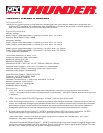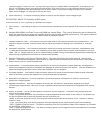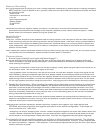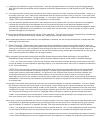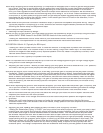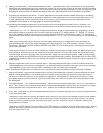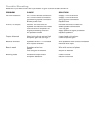No
te: When strapping two of these amplifi ers, it is important to remember that in order to get the desired power
out of them, you have to supply them with the power they need. With the current draw these amplifi ers are
capable of pulling, we at MTX highly suggest upgrading to a dual alternator setup at 600 A. At the same
time, you must upgrade the stock battery and add a couple more batteries to the system. We recommend a
minimum of three batteries with a cold cranking amp (CCA) rating of 725 or more. Please remember to install
a minimum of 1/0 AWG power and ground cable for the electrical system upgrades and the amps. Just adding
extra batteries will not solve the need for power; it will actually put more of a load on the alternator, in turn
yielding less power to the audio system.
Double check all the previous connection installation steps, in particular the speaker and power wiring. Securely
mount the amplifi er. If everything is in order, reconnect the vehicles negative battery connection and begin
following the feature setup and adjustment steps.
Feature Setup and Adjustments
1. Selecting the Input Sensitivity Range –
Before you turn on your system, you must select the proper input sensitivity range on your amp using the button
labeled INPUT SENS located in the GAIN CONTROL section of the control panel.
• Setting for Aftermarket Source Units: Refer to your aftermarket owner’s manual for line level output
specifi cation. If the specifi cation is not available, please follow the instructions listed below.
X1 POSITION: 100mV–1V (Typically for RCA Input)
• Setting for Factory (OEM) Source Units: To check the amount of voltage that is present from the source
unit, take a multi meter, or a volt/ohm meter, on the AC setting, (range from 100mV up to 10 volts) attach the
positive and negative leads directly to any exposed speaker. It will not matter if the polarity is correct, it will
read the same amount of voltage.
X10 POSITION: 1V–10V (Typically for Speaker Level Input)
Note: It is important not to have the amp set up to receive a low voltage signal and give it a high voltage signal.
Doing this can cause damage to the amp.
2. Adjusting the Gain Control – Before you start setting your amp gains, be sure to defeat all EQs (“off” position).
You want to set the gain levels properly BEFORE applying any equalization.
Start with the source unit’s volume around ¾ of the way up and the gain on the amp all the way down (counter-
clockwise). Slowly increase the gain clockwise until the speaker starts to distort. Immediately decrease gain
until the distortion goes away. This will be a good reference point on the volume control to where the signal
starts to distort. Remember every CD will be different; use common sense and constantly listen for obvious
distortion and adjust volume accordingly. The gain on the amp has nothing to do with how much power the
amp can produce, just how fast the amp puts out max power. Just like in an automobile, full throttle is very
rarely needed.
Note: When adjusting the gains for two amplifi ers strapped, you must adjust each amplifi er’s gain, frequency, and
EQ so you will be able to “match” the two amps and ensure both amplifi ers are sending the same ac voltage
to the woofer. This will require source materials that include test tones and a volt ohm/multi meter.
a) Set the volume around half, play a fl at tone (60-80 Hz) through your head unit and hit repeat. Use this same
frequency and volume for the entire process.
b) Set your multi meter on ac voltage and connect it to the Positive amplifi er’s positive and negative output
terminals.
c) Switch the multi meter between the amps and make the necessary adjustments so that the fl at tones
produced match. If you have access to two multi meters, simply place one on each amplifi er’s terminals and
make the adjustments.
3. Adjusting the Low, 24dB @ 40Hz-200Hz Variable Low Pass X-over Frequency Controls–
• Setting for Subwoofers: Using “X-OVER” you have control over what frequency you want your amp to start
crossing over your signal. By turning this control all the way counter-clockwise, you are crossing the signal
over at 40Hz (the range is counter-clockwise 40Hz to clockwise 200Hz). This means that the amp will send
the woofers frequencies from 20Hz to 40Hz and then start to taper down as the frequencies get over 40Hz
(24dB/octave roll off). The industry standard for low pass crossover point is right around 90Hz. However, by
experimenting with the crossover point (higher or lower) you will fi nd what sounds best in this install. The
decibel per octave roll off (dB/oct) means how fast the amplifi er tapers down as the frequencies get higher.
This amp uses a 24 decibel per octave roll off, which is pretty steep, or tapers off fairly quickly from the
crossover point. This design complements both the subwoofer and mids to provide greater musical detail.



